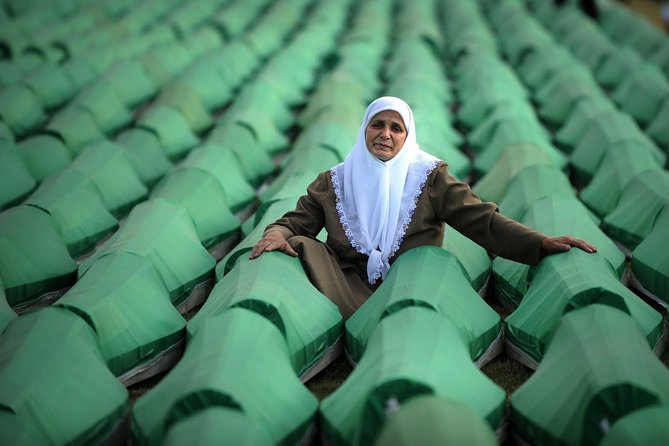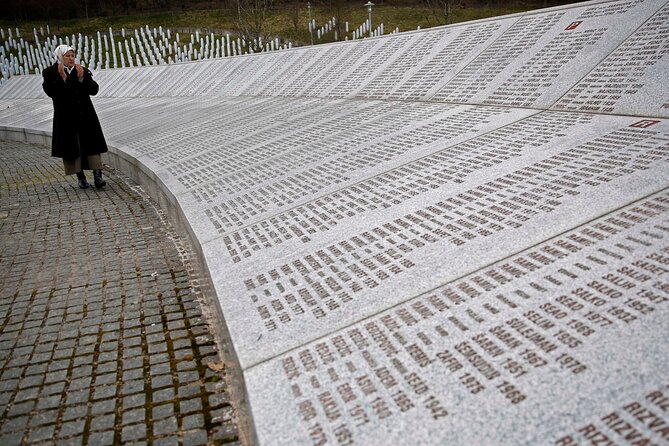The Srebrenica genocide stands as a harrowing reminder of the consequences of unchecked hatred and dehumanization. In July 1995, over 8,000 Bosnian Muslim men and boys were systematically murdered in an act of ethnic cleansing that shook the world. Today, the Srebrenica Memorial Center serves as a poignant tribute to the victims, fostering education, reflection, and a renewed commitment to preventing such tragedies. Through personal accounts and artifacts, visitors confront the gravity of this dark chapter, compelled to explore how the lessons of Srebrenica can shape a future founded on tolerance, human rights, and peace.
Key Points

- The Srebrenica Memorial Center serves as a testament to the victims of the 1995 Bosnian genocide, honoring their memory and educating visitors about this tragic event.
- Powerful eyewitness accounts from survivors provide a harrowing depiction of the systematic execution of over 8,000 Bosnian Muslim men and boys during the Srebrenica massacre.
- The international community’s failure to protect the designated "safe area" of Srebrenica underscored the need for robust UN peacekeeping mandates and better accountability for atrocities.
- Preserving the memory of the Srebrenica genocide through memorial sites and educational initiatives is crucial to prevent the recurrence of such humanitarian catastrophes.
- Promoting reconciliation, intercultural dialogue, and a commitment to upholding human rights are essential in ensuring that the lessons of Srebrenica are never forgotten.
Historical Context of Srebrenica
The Bosnian War, a conflict that erupted in the early 1990s following the breakup of Yugoslavia, set the historical stage for the tragedy that unfolded in Srebrenica.
Amid the chaos of the war, the town of Srebrenica was designated as a UN "safe area" in 1993, intended to provide refuge for Bosnian Muslims.
However, in July 1995, Bosnian Serb forces overran the enclave, leading to the systematic execution of over 8,000 Bosnian Muslim men and boys.
This devastating event, now known as the Srebrenica genocide, stands as one of the darkest chapters in modern European history and a poignant reminder of the consequences of ethnic hatred and the failure to protect vulnerable populations.
You can also read our reviews of more tours and experiences in Sarajevo.
Significance of Srebrenica Memorial Center
Amidst the harrowing history of the Srebrenica genocide, the Srebrenica Memorial Center stands as a poignant testament to the lives lost and a powerful symbol of remembrance.
The center honors the memory of the victims, providing a solemn space for reflection and education. Visitors can explore the museum’s exhibits, which recount the tragic events of July 1995 through personal accounts, artifacts, and multimedia presentations.
The center’s cemetery, where over 8,000 identified victims are laid to rest, serves as a powerful reminder of the immense human toll of the genocide.
Eyewitness Accounts of Genocide

Survivors of the Srebrenica genocide recount harrowing eyewitness accounts, painting a vivid tapestry of the horrors they endured. Eyewitnesses describe the systematic execution of men and boys, the separation of families, and the anguished cries of those torn from their loved ones.
Accounts detail the chaos and terror as Bosnian Muslims fled their homes, only to be hunted down by Bosnian Serb forces. Survivors speak of the dehumanizing conditions in overcrowded shelters, where they lived in constant fear for their lives.
These first-hand narratives underscore the immense human toll of the Srebrenica massacre, serving as a solemn reminder of the tragic consequences of ethnic cleansing and genocide.
Aftermath and International Response
In the aftermath of the Srebrenica genocide, the international community faced a reckoning. The United Nations acknowledged its failure to protect the people of Srebrenica, leading to calls for reform.
The International Criminal Tribunal for the former Yugoslavia was established to prosecute those responsible for the atrocities. Milosevic and other Serbian leaders were indicted, though Ratko Mladic, the military commander, evaded capture for over a decade.
The Dayton Peace Accords ended the Bosnian War but reinforced ethnic divisions, and Bosnia-Herzegovina struggled to rebuild.
The Srebrenica massacre is widely recognized as the worst act of genocide in Europe since World War II, prompting efforts to prevent such tragedies in the future.
Lessons Learned and Remembrance
The Srebrenica genocide served as a stark lesson for the international community, underscoring the dire consequences of inaction and the urgent need to strengthen mechanisms for preventing such atrocities. The massacre highlighted the shortcomings of the United Nations’ peacekeeping mission and the failure to protect vulnerable populations. In the aftermath, efforts were made to enhance the training and mandate of UN peacekeepers, improve early warning systems, and establish the International Criminal Tribunal for the former Yugoslavia to prosecute war crimes. Remembrance and education also became essential, with the Srebrenica Memorial Center and annual commemorations ensuring the victims are never forgotten.
| Lessons Learned | Key Reforms | Ongoing Challenges |
|---|---|---|
| UN peacekeeping shortcomings | Stronger peacekeeping mandates | Ensuring accountability |
| Failure to protect civilians | Improved early warning systems | Addressing denial and revisionism |
| Need for accountability mechanisms | Establishment of war crimes tribunals | Promoting reconciliation |
| Importance of remembrance and education | Memorial centers and commemorations | Sustaining long-term commitment |
- Sarajevo: Mostar, Konjic, Dervish House, Pocitelj & Kravice Falls
- Understanding Srebrenica Genocide Tour + Lunch With Local Family Included
- Visit Herzegovina From Sarajevo in One Day
- Sarajevo To/From Dubrovnik Transfer Tour via Mostar & Herzegovina
- Sarajevo Family Walking Tour: Cultural Gems Unveiled
- Discover Sarajevo Walking Tour With Local Guide
Visiting Srebrenica: Key Insights
A visit to Srebrenica offers a sobering glimpse into the tragic events that unfolded in July 1995, when Bosnian Serb forces massacred thousands of Bosnian Muslim men and boys in one of the darkest chapters of the Bosnian War.
The Srebrenica Memorial Center provides an immersive learning experience, allowing visitors to understand the scale of the genocide.
Exploring the former UN base and the town itself underscores the transformation from peace to tragedy.
Guided by a local expert, the tour sheds light on the historical significance of Srebrenica, fostering a deeper appreciation for the lessons that must be learned from this horrific event.
Preserving the Memory of Victims
The Srebrenica Memorial Center stands as a poignant testament to the lives lost during the 1995 genocide. This solemn site serves as a place of remembrance, honoring the victims and preserving their stories.
Visitors can explore the memorial’s exhibits, which provide harrowing details of the events that unfolded. The Potočari Memorial and Cemetery, located within the complex, offers a gravesite for the identified remains of those killed.
Through this sacred space, the memory of the victims lives on, a reminder of the importance of preventing such atrocities from occurring again. Preserving this history is crucial, ensuring that the world never forgets the tragedy that unfolded in Srebrenica.
Ensuring Such Tragedies Never Repeat
Committed to ensuring such tragedies never repeat, the Srebrenica Memorial Center stands as a powerful reminder of the importance of promoting peace, tolerance, and human rights.
The center’s initiatives focus on:
- Educating visitors about the horrors of the genocide to prevent history from being forgotten
- Advocating for justice and accountability, ensuring perpetrators are held responsible
- Fostering intercultural dialogue and reconciliation, building a future of mutual understanding
Since You Asked
How Can I Show Respect When Visiting the Memorial?
To show respect when visiting the Srebrenica Memorial, one should speak softly, avoid taking photographs, and be mindful of the solemn nature of the site as they learn about the tragic events that occurred there.
What Precautions Should I Take When Visiting Srebrenica?
When visiting Srebrenica, be mindful and respectful. Dress conservatively, avoid taking photographs without permission, and listen attentively to the guide’s insights to honor the memory of those who suffered during this tragic event.
Are There Any Local Support Services for Survivors?
The tour operators offer local support services for Srebrenica genocide survivors, including counseling and emotional support. Visitors can also learn about these resources from the tour guide to provide assistance and sensitivity during the experience.
Can I Purchase Items to Commemorate the Victims?
Yes, visitors can purchase items to commemorate the victims at the Srebrenica Memorial Center. The center sells books, posters, and other memorabilia that honor the memory of those who lost their lives in the Srebrenica genocide.
How Can I Continue Learning About the Srebrenica Genocide?
To continue learning about the Srebrenica genocide, one can join a guided tour that provides in-depth historical insights and visits memorial sites. The tour offers an intimate experience led by a local guide to deepen understanding of this tragic event.
The Sum Up
The Srebrenica genocide stands as a tragic reminder of the horrors of ethnic cleansing. The Srebrenica Memorial Center serves as a poignant space to honor the victims, educate the public, and foster a commitment to peace, tolerance, and human rights. Through continued remembrance and learning, the world must ensure such atrocities never occur again, and that the memory of those lost is preserved with dignity and respect.
More Tour Reviews in Sarajevo
Not for you? Here's more nearby things to do in Sarajevo we have reviewed
- Sarajevo: Old Town Walking Tour with Local Guide
- Sarajevo Food Tour: Eat where the locals eat
- Sarajevo: Eat, Pray, Love Tour – Local Life Experience
- From Sarajevo: Medjugorje Pilgrimage Full-Day Tour
- Sarajevo: Grand Walking Tour Through Time and Cultures
- Sarajevo Rakija Tasting Tour & Local Bites
- Sarajevo: Rafting on the Tara River & Climb to Magli
- From Sarajevo: Travnik, Jajce, Pliva Lakes & Watermills Trip
- Sarajevo in a Day – History,Tradition,War,Gastronomy
- Sarajevo: Discover Sarajevo Walking Tour with Local Guide
- Hiking around Sarajevo: Lukomir Village Full Day Hiking Tour
- Sarajevo: A Siege Story – The Tunnel of Hope Experience
